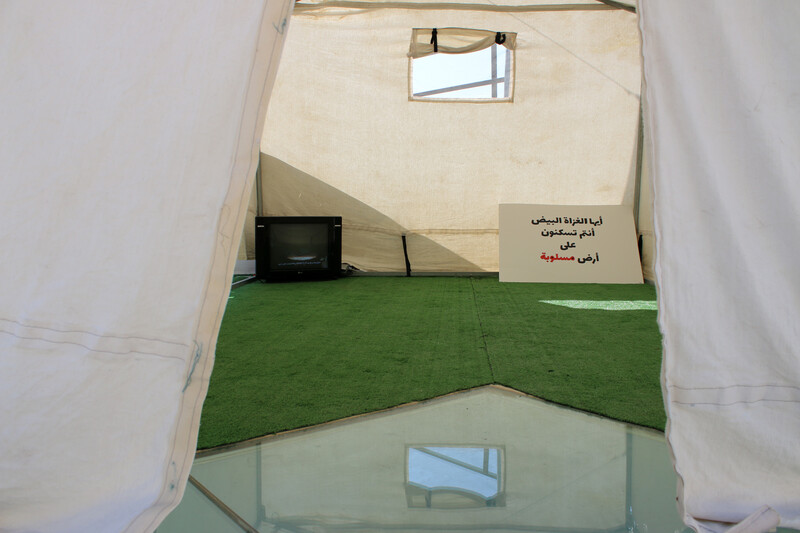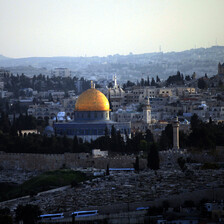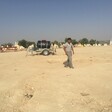The Electronic Intifada Jerusalem 21 October 2016

Richard Bell’s Aboriginal Tent Embassy.
“Survival is a very strong instinct.”
Such words resonate with Palestinians, even when spoken in a different language by a man who embraces a different struggle and lives halfway around the world.
Indeed, much of what Richard Bell, the indigenous Australian artist, had to say in Jerusalem on 14 October could have come from any Palestinian in the city, Gaza or in the diaspora.
And in the sense of showing there is a shared language among the oppressed of this world, Qalandiya International, the biennial contemporary art event, which this year is entitled This Sea is Mine, was a success.
How many Palestinians were there to reap the benefit of this wisdom, however, is less clear.
Bell was talking at an evening of “art and dialogue” in Jerusalem, where his Aboriginal Tent Embassy – an homage to the original Tent Embassy set up outside the Australian parliament some 40 years ago – formed part of Qalandiya International’s Jerusalem Show VIII: Before and After Origins.
Sitting inside the plain-looking tent, its sides raised to allow an audience to look in, and with a sign in Arabic at its front, Bell, a striking figure, spoke passionately about how his people have been oppressed, displaced, uprooted, impoverished and alienated in their own homeland.
“Colonial forces create divisions whenever and wherever they can,” Bell said on the rooftop of Al-Ma’mal Foundation for Contemporary Art in the Old City of Jerusalem where his tent had been erected. “We must find every way possible to get our message across.”
“Return to the land” is the common thread running through Qalandiya International this year. Spanning countries and borders, the biennal’s events – from photography exhibitions and solo shows to film screenings and talks like Bell’s – are held throughout historic Palestine, the occupied Golan Heights, Amman, London and Beirut. The event runs until the end of October.
According to Vivian Ziherl, the curator for the Jerusalem events, the goal of Qalandiya International is to maintain a connection among those who endure colonialism and occupation; i.e., the oppressed peoples of the world.
“Personally, I look at the concept of return from the perspective of the settler-colony,” Ziherl said, referring to her own “Anglo-Australian origins,” conceding she had only recently become familiar with the Palestinian question of return.
Return as cultural exchange
In Jerusalem, the concept of return was presented in the form of cultural exchange and expression in different localities.
On the roof of Al-Ma’mal, Richard Bell tied in the Aboriginal struggle for recognition of their rights and mere existence, with that of the Palestinians’ struggle to regain their rights and land. For both the Aborigines and the Palestinians, he said, the loss of land is an integral part of the struggle.
Next to the Tent Embassy was a sign in Arabic which read: “White invaders, you are living on stolen land.”
The local relevance was not lost on visitors.
“Just replace the word ‘white’ with ‘Zionist,’” said Nuri al-Uqbi, a Palestinian-Bedouin resident of the Naqab (Negev in Hebrew), during an informal question and answer session after Bell’s talk, “and this is our situation.”
Al-Uqbi went on to recall the manner of his community’s dispossession. He could, he said, remember the day Israel occupied Bir al-Saba (the original Arabic name for Beersheva).

Members of the Karrabing Film Collective in conversation with Richard Bell (second from right) inside the Aboriginal Tent Embassy.
He recalled how, in spite of an agreement between the local sheikhs of the Naqab’s Bedouin tribes (including al-Uqbi’s father), Israel’s military governor handed them an order in 1951 expelling them from their land in al-Araqib village and transferring them to another even more remote location, with no schools or potable water.
“There are 200,000 Arabs in the Naqab and not one owns a single piece of land,” al-Uqbi said.
The same sense of dispossession, oppression and loss of land was reflected in the words of Yasser Khanjar, a pensive, articulate poet from the Golan Heights.
Khanjar described his national identity as a Syrian whose daily life under Israeli occupation had transformed him into a Palestinian for all practical purposes. He spoke of how Israel has tried over the years to force his community to assimilate with Israeli society by preserving the Druze villages of the Golan and destroying hundreds of others during the 1967 occupation.
“They wanted us to merge with the Druze of the Galilee,” he explained, referring to the religious minority community whose leadership sought assimilation after the declaration of the State of Israel in 1948. “They wanted to make us Israeli.”
But just like Bell, who has protested for 40 years through his Tent Embassy project, Khanjar maintains his Syrian-Palestinian identity against all attempts to quell it.
“There is an Israeli settlement, Kiryat Shmona, which is only about 23 kilometers east of Majdal Shams,” he quipped, referring to his hometown. “But I would rather travel the three or so hours to Jerusalem than pass through there.”
Little local purchase
Tying displaced and oppressed peoples together through art and culture is a noble endeavor, but it must be embraced by the local population. This did not seem to be the case with Qalandiya International this year, at least if judging by the two events in Jerusalem on 14 October.
The rooftop of Al-Ma’mal – like the huge hall of the African Community Society where the Karrabing Film Collective, a group of indigenous Australian filmmakers, screened their Salt project – was well attended, but not by locals.
Introductions were made by Jerusalemites and the odd Palestinian artist or spectator could be identified in the audience, but the overwhelming majority of attendees were foreigners. Vivian Ziherl said part of the problem lies in the fact that Jerusalem poses such a challenge in terms of mobility – checkpoints and Israel’s military rule over the city.
But others believe the issue goes deeper.
Bisan Abu Eisheh, an artist who lives between Jerusalem and Glasgow, Scotland, and who is part of the Qalandiya International collaboration, said the problem is multi-layered.
“Art in Palestine has become a luxury of the elite,” he said. “My suggestion would be for institutions in Palestine to better engage locals through educational and cultural projects in order to further involve them.”
He cited the post-Oslo accords era as the starting point of this down-spiral in interest, partly due to Israel’s oppressive system of isolation and division imposed on the Palestinian territories, Jerusalem in particular.
“People were far more involved in art, dance and music before. Now the level of disinterest has risen considerably.”
A perfect case in point of this disconnect is the fact that the Tent Embassy was planned for the Shuafat refugee camp, the only camp that lies within Israel’s self-proclaimed Jerusalem municipal boundary. But organizers were forced to change venue, with Ziherl simply saying it had been “extremely hard to connect with the local population.”
She said this was not the case earlier in the week, when the Jerusalem portion of this year’s Qalandiya International had opened with “hundreds” of Palestinians in attendance.
Perhaps. Under Israel’s regime of movement restrictions, Palestinians cannot easily travel to Jerusalem (or the Golan or Haifa) if they hold West Bank identity cards – in addition to the total isolation of Gaza. Hence, the powerful messages of Richard Bell and other participating artists in the city will reach only a fraction of Palestinians.
Still, there is no denying the ties that bind the oppressed. In response to a question of what the ultimate goal is for the indigenous population of Australia, Bell voiced a sentiment all too familiar to Palestinians.
“Me? I want it all.”
Joharah Baker is a freelance writer who has worked with Palestinian, regional and international media. She is also a translator for a number of Palestinian organizations.




